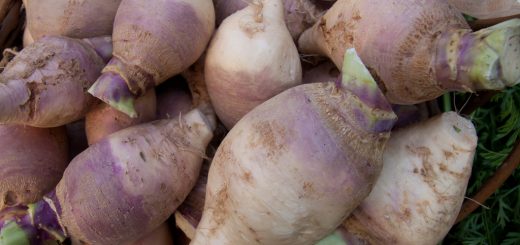Category: Featured Produce
Welcome to Summer Squash season! As you may have noticed already, summer squash appears in a variety of shapes and colors, the most prevalent being the well-known green zucchini, the straight or crooked necked yellow squash, and the round, flat, often scalloped edge, patty pan squash. All these varieties are tender, warm-season vegetables that differ from their fall and winter cousins in that they are selected to be harvested while still immature. Thus, the entire vegetable, rind, flesh, and seeds, can be eaten. (more…)
For those of you familiar with the CSA, these curly beauties are a welcome friend. For those new to the CSA experience, this may be one of your first “experimental” vegetables.
(more…)
Hakurei turnips are a Japanese salad turnip. They are sweet and much softer than a regular turnip, and rarely need to be peeled; just wash and trim the root ends. The leaves are also edible but should be eaten within 1-2 days. Wrapped tightly in plastic, the turnips can be stored in the refrigerator for up to 1 week. (more…)
It is true, eating all that salad is good for you! While the nutritional value of lettuce varies with the variety, the following excerpt from the University of Illinois website sets the record straight: Lettuce in general provides small amounts of dietary fiber, some carbohydrates, a little protein and a trace of fat. Its most important nutrients are vitamin A and potassium. (more…)
Rutabagas are only called rutabagas in the U.S. Throughout the rest of the world, they’re known as swedes. This ordinary root vegetable is thought to have originated in Bohemia in the 17th century as a hybrid between the turnip and wild cabbage.
Members of the cabbage family, rutabagas are often confused with turnips, although there are noticeable differences. Rutabagas are larger, part white and part purple, with creamy orange flesh and ribs near the stem, and with a nutty, sweet flavor when roasted. Meanwhile, turnips are white with a purple-red top and a peppery taste. (more…)
Bok Choy is technically a Chinese cabbage. But until you cook with bok choy, you cannot appreciate how special it is. It has a mellow taste compared to some of the other asian greens such as tatsoi. (more…)
The parsnip is a root vegetable related to the carrot, but white or cream colored and sweeter. Up until the potato arrived from the New World, its place in dishes was occupied by the parsnip and other root vegetables such as the turnip. (more…)
Sweet potatoes are native to Central and South America and are one of the oldest vegetables known to man. They have been consumed since prehistoric times as evidenced by sweet potato relics dating back 10,000 years that have been discovered in Peruvian caves. (more…)
Calorie for calorie, leafy green vegetables like spinach provide more nutrients than any other food. Spinach is thought to have originated in ancient Persia. Spinach made its way to China in the 7th century when the king of Nepal sent it as a gift to this country. Spinach has a much more recent history in Europe than many other vegetables. It was only brought to that continent in the 11th century, when the Moors introduced it into Spain. In fact, for a while, spinach was known as “the Spanish vegetable” in England. (more…)
The Japanese name edamame literally means “twig bean”, and is a reference to the short stem attached to the pod. This term originally referred to young soybeans in general.
Over time, however, the prevalence of the salt-boiled preparation meant that the term edamame now often refers specifically to this dish. Typically, the pods are boiled in water together with condiments such as salt, and served whole. To eat, you simply squeeze the beans out of the pods with your fingers, or your teeth! (more…)









